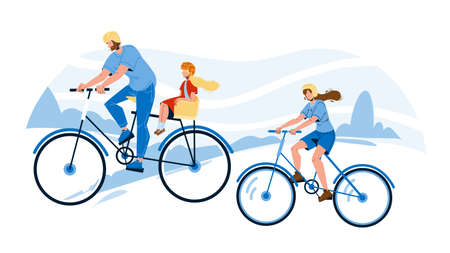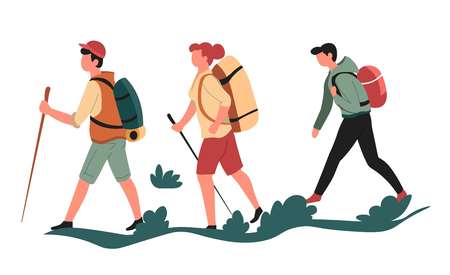Understanding Multi-Use Trails
Multi-use trails are a staple of the American outdoors, designed to accommodate various types of trail users within the same corridor. These paths aren’t just for hikers—they’re shared with mountain bikers, equestrians, runners, and sometimes even dog walkers. In the U.S., you’ll find multi-use trails winding through national forests, state parks, and even urban greenways. Each user group brings its own speed, gear, and needs to the trail, which is why understanding proper trail etiquette isn’t just about courtesy—it’s critical for safety and everyone’s enjoyment. When hikers, bikers, and horseback riders follow established protocols and respect each other’s space, it reduces accidents, minimizes conflicts, and preserves the wild experience that draws us all outdoors in the first place.
2. Right-of-Way Rules
When it comes to sharing American trails with bikers and equestrians, understanding and respecting right-of-way rules is not just about courtesy—its about safety for everyone involved. The standard right-of-way hierarchy on multi-use trails is built on decades of experience, aiming to prevent accidents and minimize stress for all trail users. Heres a breakdown of who yields to whom:
| Trail User | Yields To | Reasoning |
|---|---|---|
| Bikers (Cyclists) | Hikers & Equestrians | Bikes move faster and are more maneuverable; easier for cyclists to stop or slow down. |
| Hikers (Pedestrians) | Equestrians | Horses can be easily startled; keeping them calm is a priority for everyones safety. |
| Equestrians (Horse Riders) | N/A | Horses are large, less agile, and unpredictable if spooked. They get the right-of-way. |
Why These Conventions Matter
The logic behind this hierarchy is rooted in risk management and practicality. Horses are by far the largest and least predictable trail users. Even a well-trained horse can react unexpectedly to sudden movements or noises, putting both rider and nearby people in danger. Hikers have more control over their pace and actions than equestrians but less than bikers, who generally have the most flexibility in adjusting speed or direction.
The Unwritten Code: Communication is Key
Beyond just following the yield order, experienced trail users know that signaling intentions—whether by voice, bell, or hand signal—can avert misunderstandings before they become problems. When in doubt, slow down, make eye contact, and communicate clearly.
A Quick Reference: Who Yields to Whom?
If you’re ever unsure out there on the trail, remember this simple rule of thumb: Cyclists yield to everyone; hikers yield to horses; horses rule the path. Yield early, yield wide, and always put safety first.

3. Communicating and Making Room
On multi-use trails, clear communication is your first line of defense against confusion and accidents. Whether you’re hiking, biking, or riding horseback, letting others know you’re approaching is non-negotiable. If you’re coming up behind someone—especially bikers or equestrians—announce your presence early with a friendly but firm “On your left!” or “Coming up behind!” Don’t rely on just bells or whistles; words travel farther and are less likely to be mistaken for wildlife.
When you encounter bikers, make eye contact if possible and use hand signals or a nod to confirm who’s yielding. For equestrians, keep your voice calm and steady—a startled horse can turn a pleasant outing into an ER visit fast. Say something like, “Hello there! Passing on your left,” and wait for the rider’s cue before moving by. Remember: horses have blind spots and unpredictable reflexes.
If you need to pass, slow down and give as much space as possible. Step off the trail when safe—especially if you’re yielding to a horse or a group of bikers barreling downhill. Never assume others see you or know what you intend. When in doubt, stop and communicate directly.
In all cases, respect personal space and don’t crowd anyone, especially large animals or children. Good trail etiquette is about anticipation—think two steps ahead and always prioritize safety over speed.
4. Handling Trail Encounters with Horses
When you’re sharing the trail with equestrians, a little knowledge and a lot of respect go a long way. Horses are powerful animals, but they can be easily startled by sudden movements or unfamiliar sounds. Here’s how to handle those encounters like a pro—whether you’re on foot or riding a bike.
Understand Horse Behavior
Horses have a strong flight instinct; anything unexpected can spook them. Remember: even the calmest horse might react unpredictably if it feels threatened. That’s why your actions matter.
Trail Etiquette When Meeting Horses
| What To Do | Why It Matters |
|---|---|
| Stop and Step Aside | Give horses the right of way by stepping off the trail on the downhill side, letting them pass safely. |
| Speak Calmly | Your voice reassures both horse and rider that you’re human and not a threat hiding in the brush. |
| Avoid Sudden Movements | Quick gestures or running up behind can startle horses—keep movements slow and deliberate. |
| Keep Dogs Leashed | Uncontrolled dogs are one of the biggest threats to trail safety around horses. |
| Wait for Instructions from Riders | If unsure, ask riders what they’d prefer—some may want you to stay still, others may wave you by. |
Critical Don’ts Around Horses
- No Loud Noises: Shouting, bells, or sudden bike braking can spook even seasoned horses.
- Don’t Approach from Behind: Always make your presence known before getting close—a startled horse may kick as a defense mechanism.
- Avoid Direct Eye Contact: Staring down a horse can be misinterpreted as aggression.
- No Feeding or Touching: Never attempt to pet or feed someone else’s horse without explicit permission from the rider.
Tactical Tips for Trail Survival with Equestrians
- If you’re biking, dismount and stand on the downhill side of the trail until the horse passes.
- If visibility is poor (corners, thick brush), announce yourself before you come into view: “Biker/hiker coming up!” in a calm tone.
- If you’re in a group, gather everyone together rather than scattering around the trail—this helps riders keep track of all people and pets at once.
- If your gear includes brightly colored rain jackets or backpacks, take care not to flap them suddenly near horses; colors aren’t the issue, but sudden movement is.
The Bottom Line: Respect Is Survival
Sharing trails with horses isn’t just about courtesy—it’s about safety for everyone. When in doubt, yield and communicate. Your caution and respect make sure everyone gets home in one piece—including the 1,200-pound animal sharing your path.
5. Mountain Bike Interactions
When sharing the trail with mountain bikers, hikers must be proactive and alert—especially on mixed-use trails popular in the U.S. The golden rule: bikers yield to hikers and equestrians, but real-world scenarios demand quick thinking and mutual respect from everyone. Here’s how to keep things smooth and safe.
Trail Awareness is Your Survival Tool
Always stay alert to your surroundings. Bikers can approach fast and quietly, especially on downhill runs or blind corners. Keep one earbud out if you’re listening to music and frequently scan the trail ahead. If you spot a biker approaching, make eye contact early and signal your intentions—don’t just freeze up or make unpredictable moves.
Step Aside—But Do It Smart
If a cyclist is coming toward you, move to the side of the trail (usually right side unless signage says otherwise). Pick a spot that’s safe for both you and the biker—avoid narrow spots or areas with steep drop-offs. Stop, stand still, and give a clear path. When being overtaken from behind, listen for verbal cues like “On your left!” Respond quickly by moving right and acknowledging their presence with a nod or “Go ahead.”
Mutual Respect Makes the Trail Work
Respect goes both ways—even if cyclists are supposed to yield, sometimes momentum or terrain makes it safer for hikers to give way. Don’t assume every rider will see you in time; bright clothing and making yourself visible can help prevent close calls. A friendly “Thanks!” or wave after an interaction goes a long way in building good vibes between user groups.
Quick Decisions, No Drama
If you’re hiking with kids or dogs, keep them close as soon as you hear or see a cyclist. Stay off jumps or features designed for bikes—they’re not rest stops. In high-traffic areas, hike single-file to minimize congestion and confusion. Bottom line: stay sharp, communicate clearly, and prioritize safety over ego every time.
6. Leave No Trace and Safety Basics
When you’re sharing the trail with bikers and equestrians, playing your part in preserving the wild is non-negotiable. The Leave No Trace principles aren’t just a nice idea—they’re ground rules for anyone serious about outdoor survival and stewardship. First up: pack out every scrap of trash, food wrappers, and even biodegradable waste like orange peels or apple cores. Trails across America are under pressure from heavy use, and nothing ruins the experience faster than stumbling on litter left by someone who didn’t care.
Stick to established paths, no matter how tempting that shortcut looks. Cutting corners or creating new trails leads to erosion and damages fragile ecosystems, making the outdoors less safe and enjoyable for everyone—bikers, riders, hikers, and wildlife alike. If you see damage or obstacles on the trail, report it to local authorities or park rangers instead of trying to fix it yourself; professionals know how to handle it without causing more harm.
Safety goes hand in hand with responsibility. Stay alert—whether you’re hiking, biking, or riding horseback. Always yield appropriately (hikers step aside for horses, bikers yield to both) but do so carefully, avoiding sudden moves that could startle a horse or cause an accident. When stopping for a break, pick durable surfaces off the main trail so you don’t block traffic or trample delicate plants.
Bring the right gear: first aid kit, plenty of water, weather-appropriate clothing, and a map or GPS—cell service can be spotty in remote areas. Let someone know your route and estimated return time before heading out. Emergencies happen fast on the trail; being prepared can mean the difference between a minor inconvenience and a major crisis.
Above all else, respect is key. Respect the land by leaving it better than you found it. Respect other users by following protocols and communicating clearly—especially when approaching on blind curves or narrow passes. And respect yourself by acting responsibly at all times. That’s how we keep America’s trails open and wild for generations to come.
7. Key Takeaways for a Respectful Trail Experience
Sharing the trail with bikers and equestrians requires more than simply following a set of rules—it demands a mindset rooted in respect, awareness, and adaptability. Here are the practical takeaways every trail user should keep front and center to ensure that everyone enjoys a safe, positive experience:
Yielding is Not Optional—It’s Essential
Always remember: hikers yield to horses, and bikers yield to both hikers and equestrians. If you’re unsure who has the right of way, stop, communicate clearly, and proceed only when it’s safe.
Communication Prevents Conflict
Make your presence known early—use your voice, not just bells or horns. A simple “hello” or “on your left” can help avoid startling horses or surprising other users around blind corners.
Stay Visible and Predictable
Stick to the right side of the trail unless passing. Avoid sudden movements or loud noises, especially near horses. If you’re biking, control your speed; if hiking with pets, keep them leashed and close.
Leave No Trace—Respect the Land and Each Other
Carry out what you carry in. Stay on established trails to prevent erosion and habitat damage. Don’t shortcut switchbacks or create new paths. The best etiquette is invisible: leave no evidence but your footprints (or tire prints or hoofprints).
Cultivate a Cooperative Mindset
Approach each encounter with patience and empathy. Assume good intentions from fellow trail users, even if their actions aren’t perfect. A friendly greeting or nod goes a long way toward building a cooperative trail culture.
Your Responsibility Doesn’t End With You
Set an example for others by modeling good behavior. Gently remind newcomers about protocols when needed—most folks appreciate the guidance. Remember: every positive interaction contributes to safer, friendlier trails for all.
If we all commit to these principles—yielding appropriately, communicating clearly, respecting nature, and looking out for one another—the trail becomes more than just a path through the woods; it becomes common ground where adventure, safety, and camaraderie coexist.

